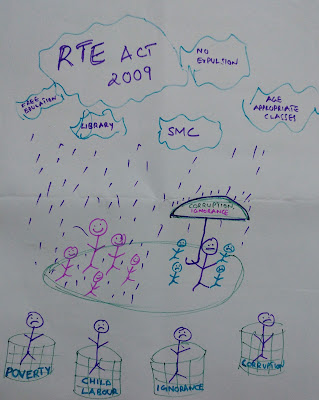RTE Act: #realitycheck
Sarva Shiksha Abhiyan (Education for All Movement)
was an intervention programme by the Indian Government to universalize
elementary education in a time-bound manner, which became operational since
2000-01. SSA proposed provisions such as free and compulsory education to all
children between the ages of 6 and 14, by observing right to education as a
fundamental right of the child. The fact being that SSA had no legal backing
and on finding that proposals as under SSA will play a major role in shaping
India’s future, 'The Right of Children to Free and Compulsory Education Act', commonly
known as the ‘RTE Act 2009’ came into existence on 4th
August 2009. The act entitled free and compulsory education to every child in
India between the ages of six and fourteen, as proposed by SSA. With the enaction
of the Act, India became one among the 135 nations of the world to make
education a fundamental right to all children.
Few of the
provisions as under the RTE Act 2009 are:
1) Free and compulsory elementary education
to every child between the age of 6 and 14.
2) Any child not admitted to school
before shall be admitted to age appropriate class. Such a child has a right to
receive special training such that he/she becomes at par with others.
3) No screening for admission to
elementary classes.
4) No child shall be detained until
class 8
5) 25% reservation of seats in
non-minority private, aided and un-aided schools for children from disadvantaged
and weaker sections
6) Every school is supposed to have facilities
such as drinking water, library, play materials, playground and separate toilets
for boys and girls.
7) Every school is supposed to have a School
Management Committee (SMC). The
SMC is to plan, manage and monitor the school activities in collaboration with
the local authority.
8) Bars corporal punishment and mental harassment
of students.
9) A teacher-student ratio of 1:30 in
primary and 1:35 in upper primary section.
10) Subject teachers for upper-primary
classes and one teacher for every class.
The act has
lot many provisions for betterment of education in our country, yet many of it
are not seen executed on ground. The act was discussed in our zone as part of our Leadership Curriculum and a few of the gaps in the execution of the Act as it turned
out are as follows:
1) Corruption: Corruption happens at all
levels and is preventing the information and resources reaching the ones who
most need it.
2) Ignorance: Parents are ignorant of the
provisions of the Act and the right their children has for free education.
Teachers are ignorant of the content of the Act and the right to address to
specific bodies, the lack of amenities proposed by the Act
3) Child Labour: Although child labour
has been abolished in India by law, it still exists, preventing children from
attending school. The social and economic factors attached to it is a different
story.
4) Effectiveness: India has 1000s of
NGOs working in the education sector and still 1.4 million children aged
between 6 and 11 are out of school in India.
Recently I conducted
a presentation on the RTE Act for the teachers in one of the schools I work
with. It turned out that none of the teachers had read the Act before or were
conscious of the provisions of the Act. The school has no SMC and some of them
were not even aware of what an SMC was. I addressed this concern of the teachers
- even after being one of the main stakeholders in the education sector - not
being fully aware of the RTE Act in a session we had with Ms. Hemangi Joshful,
a member of the RTE Forum. The reply was that it is not mandated by any means.
Also it was inferred from the session that if anyone notices any violation in
RTE Act, the issue can be addressed to the State Commission for Protection of
Child Rights (SCPCR) or the National
Commission for Protection of Child Rights (NCPCR).
The Act
talks in terms of admission to schools and the mandatory facilities in schools,
but nowhere it mentions the quality of learning. Also, there is nothing specified about the educational qualification of teachers. As rightly mentioned by my
co-fellow Arun SM, the Act is more of an input oriented one, rather than
outcome oriented.




Comments
Post a Comment